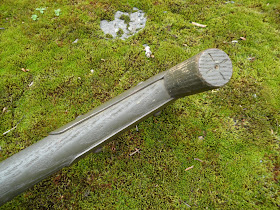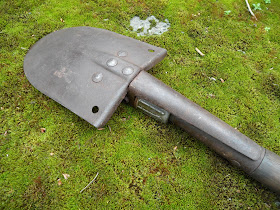Here is the next shovel in our series.

This shovel is a very nice example of one of the WW2 produced, Model 1910, T-Handle shovels.
When the US entered WW2, the first troops were issued the old WW1 surplus Model 1910 shovels. After the last of the old shovels were issued, the US Military made another production run of the old style shovels, in 1942 and 1943.
The old WW1 surplus Model 1910 shovels were not dated and did not have the manufacturer stamped on them, they only had "US" stampings. They were also not painted.
Here is a link to my posting on one of the old WW1 versions in my collection:
http://sharky-fourbees.blogspot.com/2015/10/us-model-1910-t-handle-trench-shovel.html
All of the WW2 produced shovels are dated 1942 or 1943, and have the manufacturer stamped on them. There were a number of different companies that made these shovels during the 2 years of the war that they were produced. The WW2 versions were also painted green. (The reissued WW1 versions were often painted green in the field during the war, but are not dated).
My shovel is marked with the company stamp of C.H. & I. Co. Inc., and is dated 1943. This company was contracted to supply replacement handles at the beginning of WW2. It is my guess that when the US Military put out the contracts for new production T-Handle shovels, they supply could not keep up with the demand to equip the troops. To augment the supply of new shovels, a parallel program of refurbishing the old WW1 contract shovels was started. This would explain the shovels with the C.H. & I. Co. handles. The shovels that have these manufacturing markings, most certainly came from that refurbishing line. (This is just my best educated deduction, yet to be confirmed)

1943 was a "transition year" for US shovels. The new folding shovels were first produced and issued in 1943, as the last of the T-Shovels were made. You will find 1943 dated folding shovels and T-Handles.
The WW1 production T-Handle shovels are always stamped "US" on the metal shank of the blade, and on the wood. The pre-WW1 shovels that were made at Rock Island Armory, are not tamped US, or dated.
There are also small wood filler-wedges driven in next to the wood handle were it enters the metal blade shank.
The T-Handle shovels were issued with a khaki, canvas shovel cover that could be worn attached to the belt or on the back of the pack. Here are two photos of marines during the island fighting in WW2, that show both ways that the shovel was carried.
 |
| The Marine on the right is wearing his shovel on the belt. |
 |
| The Marine on the right has his shovel attached to the pack. |
With all that said, let's take a look at the photo album of this WW2 shovel:
 |
| In this photo you can see the wood wedge in the handle-to-metal gap. |






































































